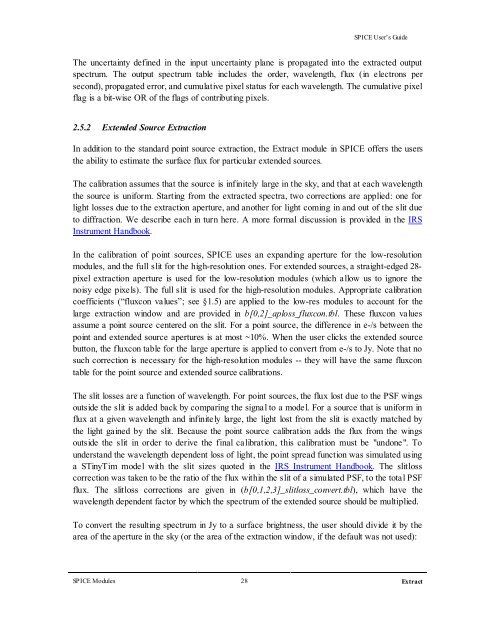SPICE User's Guide - IRSA
SPICE User's Guide - IRSA
SPICE User's Guide - IRSA
You also want an ePaper? Increase the reach of your titles
YUMPU automatically turns print PDFs into web optimized ePapers that Google loves.
<strong>SPICE</strong> User’s <strong>Guide</strong><br />
The uncertainty defined in the input uncertainty plane is propagated into the extracted output<br />
spectrum. The output spectrum table includes the order, wavelength, flux (in electrons per<br />
second), propagated error, and cumulative pixel status for each wavelength. The cumulative pixel<br />
flag is a bit-wise OR of the flags of contributing pixels.<br />
2.5.2 Extended Source Extraction<br />
In addition to the standard point source extraction, the Extract module in <strong>SPICE</strong> offers the users<br />
the ability to estimate the surface flux for particular extended sources.<br />
The calibration assumes that the source is infinitely large in the sky, and that at each wavelength<br />
the source is uniform. Starting from the extracted spectra, two corrections are applied: one for<br />
light losses due to the extraction aperture, and another for light coming in and out of the slit due<br />
to diffraction. We describe each in turn here. A more formal discussion is provided in the IRS<br />
Instrument Handbook.<br />
In the calibration of point sources, <strong>SPICE</strong> uses an expanding aperture for the low-resolution<br />
modules, and the full slit for the high-resolution ones. For extended sources, a straight-edged 28pixel<br />
extraction aperture is used for the low-resolution modules (which allow us to ignore the<br />
noisy edge pixels). The full slit is used for the high-resolution modules. Appropriate calibration<br />
coefficients (“fluxcon values”; see §1.5) are applied to the low-res modules to account for the<br />
large extraction window and are provided in b[0,2]_aploss_fluxcon.tbl. These fluxcon values<br />
assume a point source centered on the slit. For a point source, the difference in e-/s between the<br />
point and extended source apertures is at most ~10%. When the user clicks the extended source<br />
button, the fluxcon table for the large aperture is applied to convert from e-/s to Jy. Note that no<br />
such correction is necessary for the high-resolution modules -- they will have the same fluxcon<br />
table for the point source and extended source calibrations.<br />
The slit losses are a function of wavelength. For point sources, the flux lost due to the PSF wings<br />
outside the slit is added back by comparing the signal to a model. For a source that is uniform in<br />
flux at a given wavelength and infinitely large, the light lost from the slit is exactly matched by<br />
the light gained by the slit. Because the point source calibration adds the flux from the wings<br />
outside the slit in order to derive the final calibration, this calibration must be "undone". To<br />
understand the wavelength dependent loss of light, the point spread function was simulated using<br />
a STinyTim model with the slit sizes quoted in the IRS Instrument Handbook. The slitloss<br />
correction was taken to be the ratio of the flux within the slit of a simulated PSF, to the total PSF<br />
flux. The slitloss corrections are given in (b[0,1,2,3]_slitloss_convert.tbl), which have the<br />
wavelength dependent factor by which the spectrum of the extended source should be multiplied.<br />
To convert the resulting spectrum in Jy to a surface brightness, the user should divide it by the<br />
area of the aperture in the sky (or the area of the extraction window, if the default was not used):<br />
<strong>SPICE</strong> Modules 28 Extract





